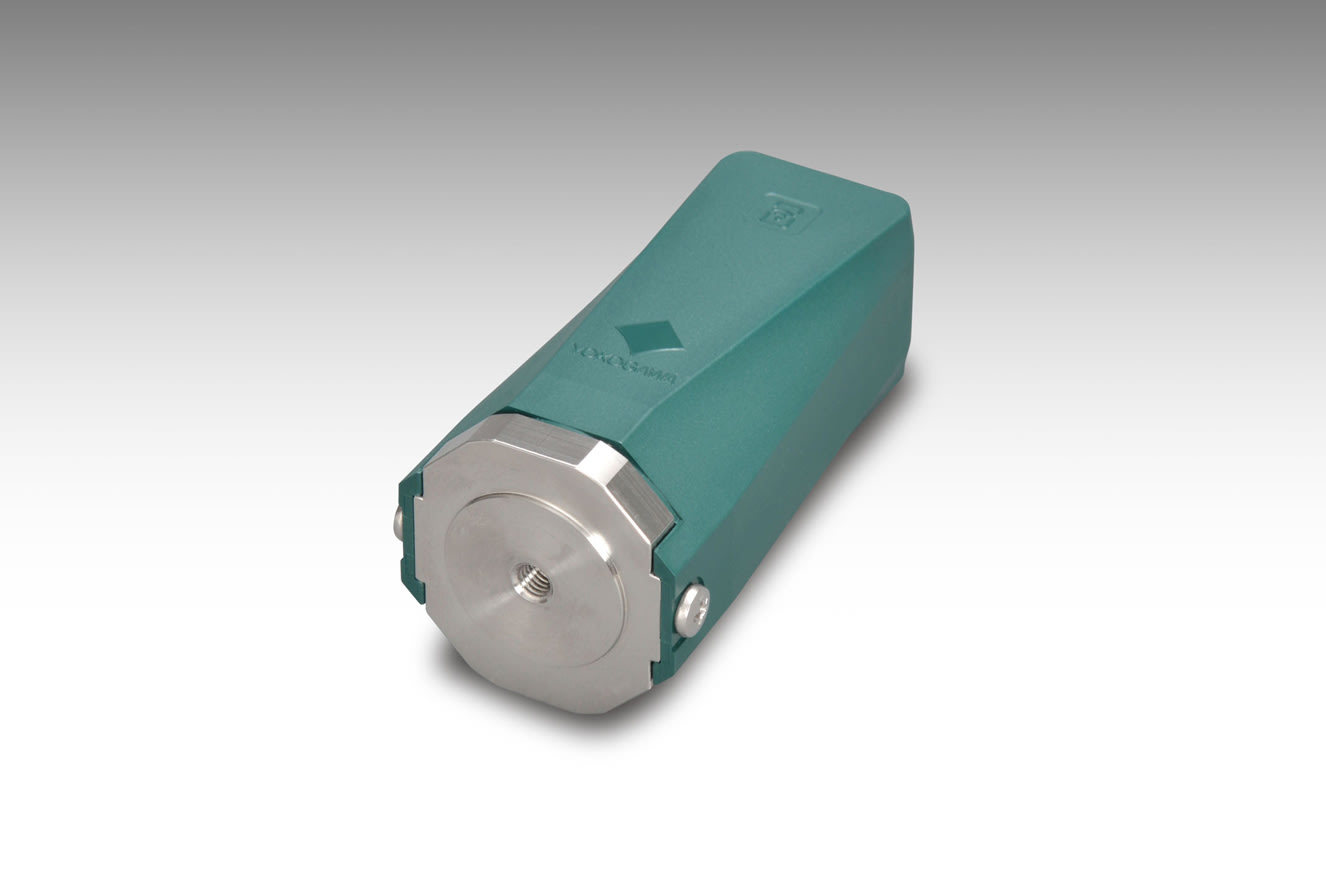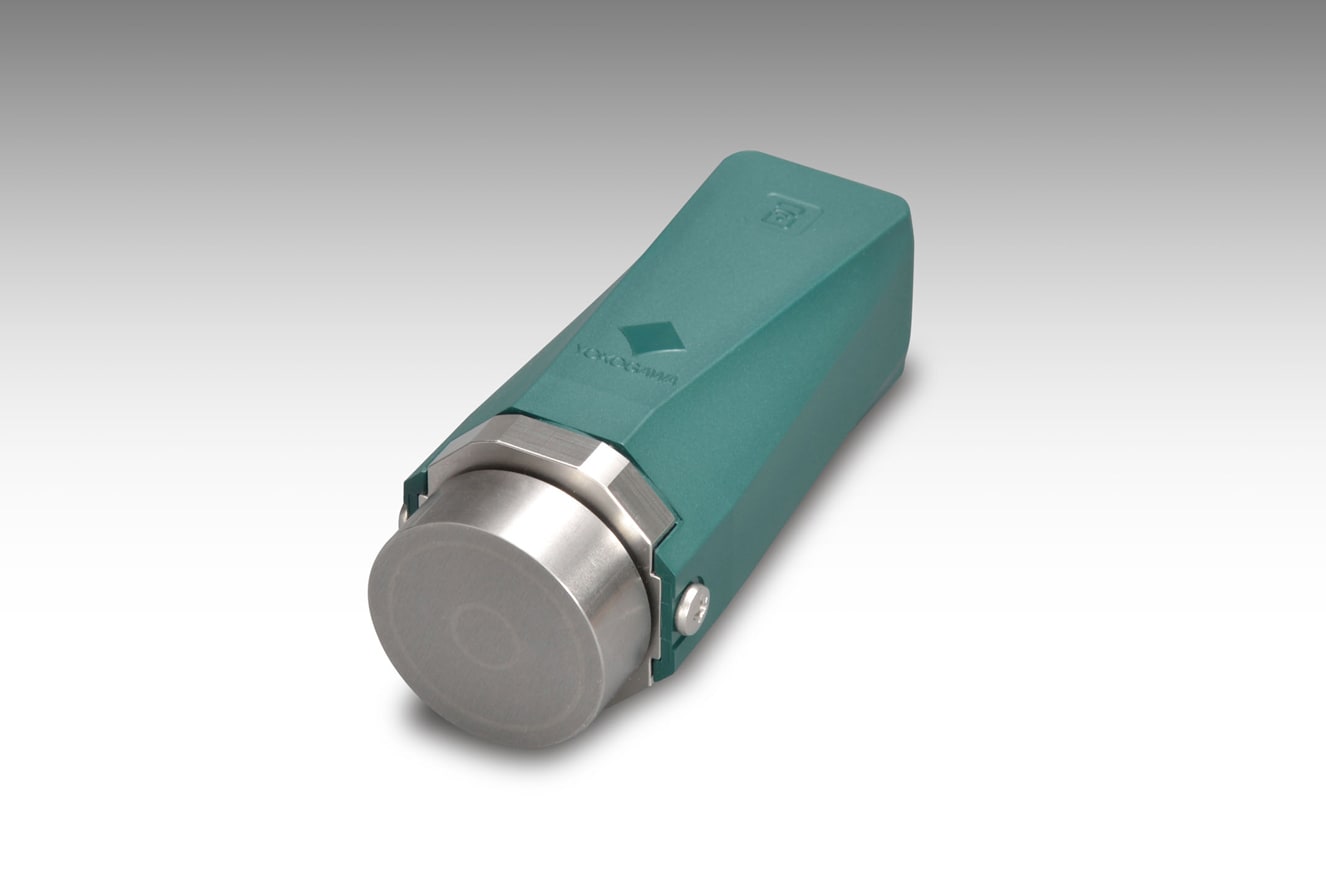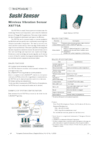A battery-powered wireless vibration sensor with sensor and wireless communication functions integrated into a single unit. Suitable for Industrial IoT (IIoT) applications, the XS770A Wireless Vibration Sensor measures vibration (velocity and acceleration) along the X, Y, and Z axes and 3-axis composite in addition to monitoring the surface temperature of the bottom. Measurement data is transmitted to the host systems via wireless communication.
The XS770A can be mounted easily by a screw or a magnet.
Details
XS770A Wireless Temperature and Vibration Sensor Module
Improve productivity with the XS770A vibration wireless sensor.
Durable enough for hazardous locations and powerful enough to transmit data up to 6 miles/10 km, the battery-powered XS770A can configure multiple applications via a single smartphone Near Field Communication (NFC) interface.
Wireless Vibration Monitoring System of Industrial Equipments
Streamlined wireless industrial monitoring system design allows users to easily monitor measurement data, anticipating equipment issues before they arise and affect bottom-line profitability. Installation is equally convenient since the sensor only requires a magnet or screw.
- Supports Zone 2 hazard location installation
- Capable of communicating up to 6 miles/10 km
- Easily monitor sensor status from a smartphone
What Are the Benefits of Wireless Vibration Sensors?
Wireless Vibration Sensors are screw or magnet-mounted sensors that measure vibration (velocity and acceleration) along the X, Y, and Z axes and 3-axis composite as well as monitoring the surface temperature and enabling remote vibration analysis. They can be installed in Zone 2 areas, such as petrochemical plants, paint plants, drug plants, or any location where flammable gas or vapor may exist. In addition, they are capable of long-distance communication and their batteries can last up to 10 years.
 Hazardous Location Installation
Hazardous Location Installation
The XS770A can be installed in Zone 2 areas, such as petrochemical plants, paint plants, drug plants, where flammable gas or vapor may exist.
Long-Distance Communication
LoRaWAN has excellent sensitivity reception, good radio interference resistance, and offers a communication distance of six miles (10 km) or more in ideal conditions. This sensor can be installed anywhere need - over a vast area.
Excellent Environmental Resistance and Battery Powered
The XS770A has a built-in replaceable battery that can last up to 10 years. This waterproof, dust-proof, and explosion-proof wireless pressure monitor can operate in harsh environments can be installed anywhere in a plant (no power cables required).
Configuration and Wireless Condition Monitoring Sensor Status from a Smartphone
Using an Android-based smartphone with NFC (Near Field Communication) interface makes configuration and status monitoring of sensors simple and intuitive.
What is Vibration Monitoring?
Industrial vibration monitoring is a method of monitoring equipment vibration to check equipment health and detect malfunctions. Many plants continue to depend on periodic manual vibration monitoring, which leaves the possibility open to miss vibration events and related malfunctions. This can lead to costly and unanticipated interruptions and shut-downs.
What is a Wireless Vibration Sensor?
The XS770A wireless vibration sensor monitors trends in equipment's vibration and temperature to detect abnormalities early, and it uses machine learning to analyze equipment data. The remote vibration sensor increases the scope of monitoring and reduces the risk of missing an unusual behavior. Its wireless capabilities enable remote measurement at heights or hazardous locations to improve operators' safety.
XS770A Wireless Vibration Sensor
| WIRELESS SPECIFICATIONS | Communication Protocol | LoRaWAN class A EU868, AS923, US915, KR920, AU915 |
||
|---|---|---|---|---|
| Data Rate | 250 to 11000 bps*1 | |||
| Frequency | Available frequency bands vary depending on the country. Please check General Specifications for details. |
|||
| Radio Security | AES 128-bit encryption | |||
| RF Transmitter Power | Max. 7 dBm | |||
| Antenna | Built-in Omni-directional antenna | |||
| POWER SUPPLY SPECIFICATIONS | Battery | Lithium thionyl chloride battery: 1 unit (dedicated product) Rated voltage: 3.6 V Rated capacity: 2.6 Ah |
||
| PERFORMANCE SPECIFICATIONS | Measurement | Vibration | Measurement | Acceleration (peak), Velocity (RMS) |
| Axis | X, Y, Z axes and 3-axis composite | |||
| Range *2 | Acceleration: 0 to 130 m/s2 (0 to 13.26 g) Velocity *3: 0 to 20 mm/s (0 to 0.79 in/s) |
|||
| Frequency range | 10 to 1,000 Hz (± 3 dB) | |||
| Accuracy (100 Hz) | X, Y, Z axes: ±10% FS 3-axis composite: ±20% FS |
|||
| Temperature | Measurement | Temperature | ||
| Range | -20 to 85°C (-4 to 185°F) | |||
| Resolution | 0.1°C | |||
| Measurement part | Base | |||
| Update Time | 1 minute to 3 days | |||
| Battery Characteristics | The typical battery life is 4 years in the following conditions.*4 • Update period: 1 hour • Ambient temperature: 23±2°C (73.4±3.6°F) |
|||
| FUNCTIONAL SPECIFICATIONS | Output | LoRaWAN*5 | ||
| NFC Interface | NFC Forum Type 2 Tag | |||
| INSTALLATION ENVIRONMENT | Ambient Temperature Limits | Operating: -20 to 85°C (-4 to 185°F)*6 | ||
| REGULATORY COMPLIANCE STATEMENTS | Degrees of Protection | IP66/IP67 and Type 4X*6 | ||
| Explosionproof | ATEX, IECEx, FM | |||
| PHYSICAL SPECIFICATIONS | Housing Material | For detail, refer to “MODEL AND SUFFIX CODES” in General Specifications. | ||
| Weight | 260 g (0.57 lb) | |||
| Mounting | Mounting on the measurement target using the screw*7 | |||
*1: Available data rates vary depending on the country.
*2: Peak value of the input vibration. For the relation between the measurement frequency band and measurable range, refer to General Specifications.
*3: The 20 mm/s pk value is equivalent to 14 mm/s RMS when input is based on a sine wave.
*4: Environmental conditions such as vibration and the type of the connected device may affect battery life.
*5: For detail on the channel plan, refer to General Specifications.
*6: Depends on the selected code. For detail, refer to General Specifications.
*7: Can also mount using the magnetic holder supplied as an accessory. Note that, when using the magnetic holder, the vibration measurement frequency band drops.
Sushi Sensor App
This software is used to perform the setting and status check of this product via the NFC interface.

| Operating Environment | Item | Recommended System Requirements |
|---|---|---|
| OS | Android 5.1.1 or higher | |
| CPU | Snapdragon 800 or better | |
| Resolution | 1280 x 720 dots or more | |
| NFC | Readers, Writer | |
| GPS | Optional |
What Are the Industrial Applications of a Wireless Vibration Sensor?
Wireless vibration analysis streamlines processes in the following industries:
- Oil, petrochemicals, chemicals, electric power, and gas
- Iron and steel, non-ferrous metals
- Rubber, pulp and paper
- Foods and pharmaceuticals
- Cement, construction, maintenance service, infrastructure (roads, bridges, tunnels)
- Rotary machine vendors
- Printing and publishing
- Automobile parts, electrical appliances, IT
Resources
Automated wireless vibration monitoring improves safety and exposes rotating equipment (rollers, driers, etc.) conditions in polyester textile production lines.
This eBook explains why implementing IIoT based digital operator monitoring solutions for autonomous anomaly detection enhances operations.
Wireless sensors and the network can reduce expenses
Downloads
Brochures
Instruction Manuals
General Specifications
- XS770A Wireless Vibration Sensor (766 KB)
Engineering Tools
- XS770A Wireless Vibration Sensor (549 KB)
Videos
The measurement, collection and utilization of equipment data by the Industrial IoT (IIoT) wireless solution “Sushi Sensor” contributes to efficient equipment maintenance and open a new road to a Smart Factory.
Looking for more information on our people, technology and solutions?
Contact Us




















